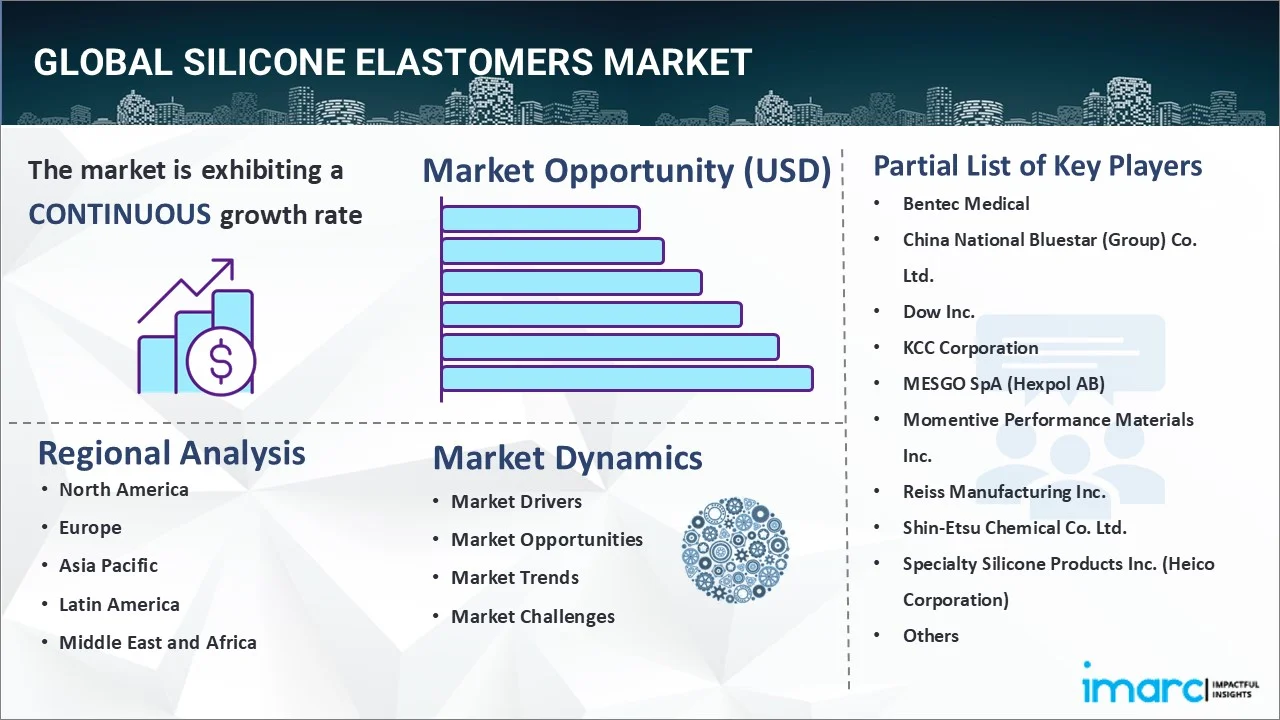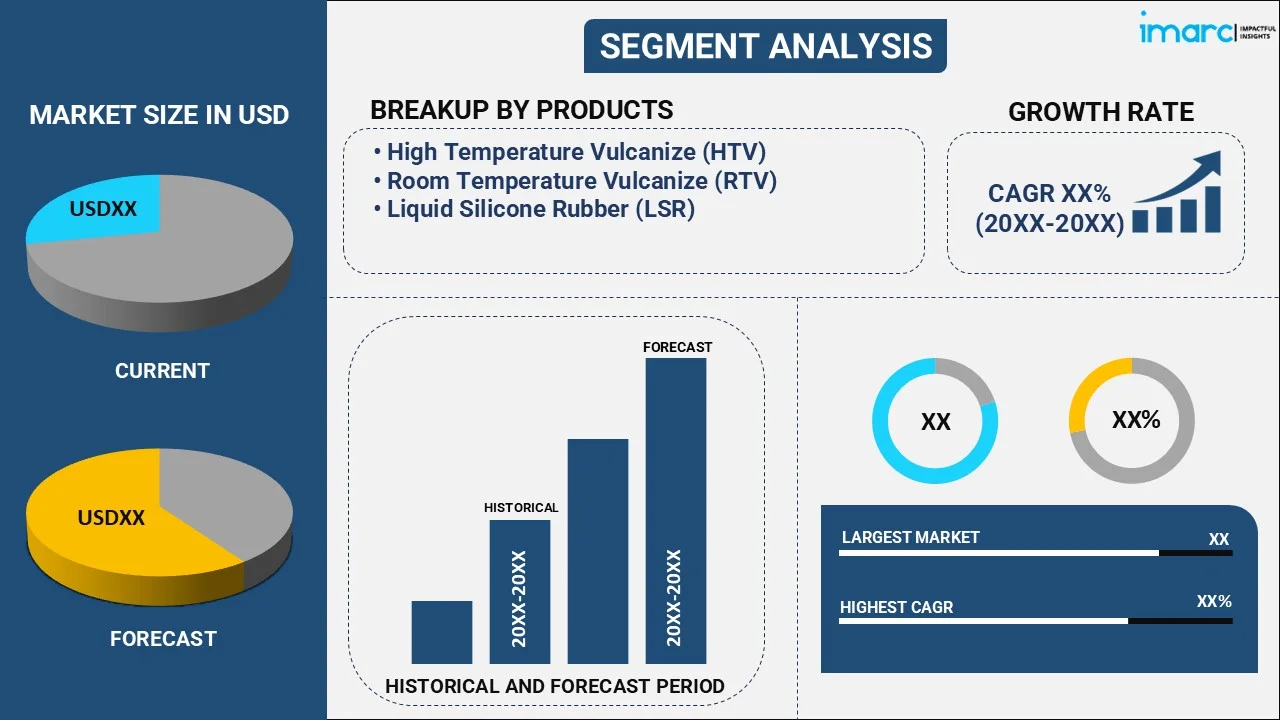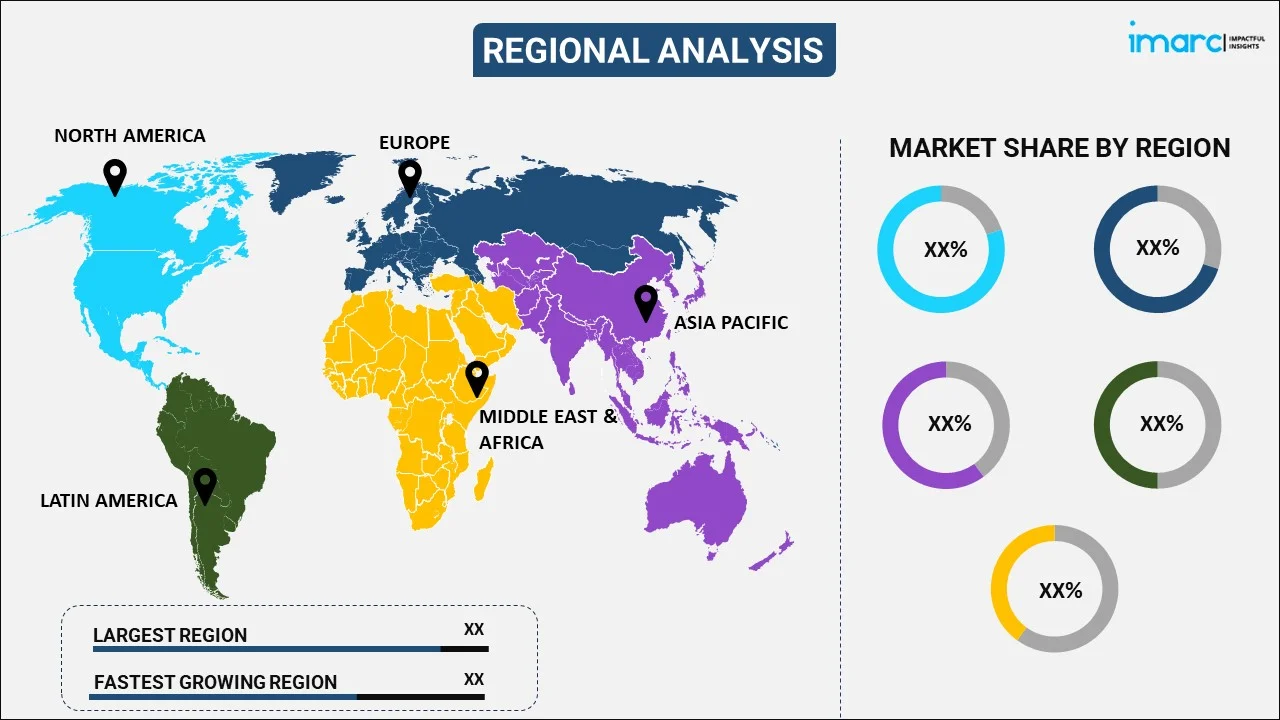
Silicone Elastomers Market Report by Product (High Temperature Vulcanize (HTV), Room Temperature Vulcanize (RTV), Liquid Silicone Rubber (LSR)), Application (Electrical and Electronics, Automotive and Transportation, Industrial Machinery, Consumer Goods, Construction, and Others), and Region 2025-2033
Market Overview 2025-2033:
The global silicone elastomers market size reached USD 9.4 Billion in 2024. Looking forward, IMARC Group expects the market to reach USD 14.8 Billion by 2033, exhibiting a growth rate (CAGR) of 4.89% during 2025-2033. The market growth is robust, driven primarily by the increasing demand in industries such as automotive, healthcare, and electronics, due to their durability and versatility. The market forecast anticipates steady expansion in the coming future, with innovations in manufacturing and eco-friendly alternatives boosting the demand.
|
Report Attribute
|
Key Statistics
|
|---|---|
|
Base Year
|
2024
|
|
Forecast Years
|
2025-2033
|
|
Historical Years
|
2019-2024
|
|
Market Size in 2024
|
USD 9.4 Billion |
|
Market Forecast in 2033
|
USD 14.8 Billion |
| Market Growth Rate (2025-2033) | 4.89% |
Also known as silicone rubbers, silicone elastomers are made by combining linear polymers, reinforcing agents, cross-linkers, and catalysts. They assist in providing heat and moisture resistance, flame retardancy, and weatherability. They also offer dielectric properties to insulate and protect electronic equipment like high voltage lines. At present, silicone elastomers are widely available in a variety of forms, including electrically and thermally conductive, open-cell foams and closed-cell sponges.

Silicone Elastomers Market Trends:
Increase in EV Production
The surge in electric vehicle (EV) production is significantly boosting the demand for high-performance silicone components. According to industry reports, in 2023, global electric car sales reached nearly 14 million, with China, Europe, and the United States accounting for 95% of the sales. Electric cars represented 18% of all cars sold, a significant increase from previous years. China led in electric car registrations with 8.1 million in 2023, marking a 35% increase from 2022. Silicone elastomers play a crucial role in managing heat generated by EV batteries and power electronics, ensuring optimal thermal performance and preventing overheating. These materials are used in gaskets, seals, and thermal interface materials due to their excellent thermal stability, flexibility, and durability. Additionally, silicone components enhance the reliability of EVs by providing effective insulation and protection against vibrations and environmental factors. As the EV market expands, the need for advanced silicone solutions grows, driving innovation and increasing market opportunities for silicone elastomer manufacturers.
Rising Demand from Personal Care Industry
Silicone elastomers play a pivotal role in cosmetics and personal care products due to their unique properties. Their smooth texture enhances the application and feel of products like foundations, primers, and skincare items, providing a silky and even finish. Moreover, silicone elastomers offer durability and long-lasting performance, ensuring that cosmetics remain intact throughout the day without smudging or fading. Additionally, their water-resistant nature makes them ideal for products that require resistance to sweat and moisture, such as waterproof mascaras and long-wear lipsticks. These elastomers also create a protective barrier on the skin, locking in moisture and improving the efficacy of skincare formulations. Furthermore, silicone elastomers contribute to the lightweight and non-greasy feel of many personal care products, enhancing user comfort and satisfaction. The increasing demand for high-performance, long-wearing cosmetics drives the continuous innovation and expansion of silicone elastomer applications in the beauty industry, making them indispensable for both manufacturers and consumers seeking quality and reliability.
3D Printing and Additive Manufacturing
Advances in 3D printing and additive manufacturing are transforming the silicone elastomers market by enabling the creation of more complex and customized products. These technologies allow for precise control over material properties and intricate designs that were previously difficult or impossible to achieve with traditional manufacturing methods. As a result, manufacturers can produce tailored silicone components that meet specific client requirements, enhancing functionality and performance in applications such as medical implants, automotive seals, and consumer electronics. Additionally, 3D printing reduces production lead times and costs by minimizing material waste and allowing rapid prototyping. For instance, in September 2023, Formlabs launched Silicone 40A Resin, the first pure silicone material for Form 3D printers, enabling efficient and affordable 100% silicone part production. With exceptional material properties, it is ideal for rapid prototyping, low-volume end-use parts, manufacturing aids, and medical applications. This advancement empowers businesses to create end-use quality parts in-house, accelerating product development, reducing downtime, and saving costs. This flexibility fosters innovation, accelerates product development, and expands the range of applications for silicone elastomers, driving market growth and competitiveness, thereby increasing the overall silicone elastomers market share.
Key Market Segmentation:
IMARC Group provides an analysis of the key trends in each sub-segment of the global silicone elastomers market report, along with forecasts at the global, regional and country level from 2025-2033. Our report has categorized the market based on product and application.
Breakup by Product:

- High Temperature Vulcanize (HTV)
- Room Temperature Vulcanize (RTV)
- Liquid Silicone Rubber (LSR)
Breakup by Application:
- Electrical and Electronics
- Automotive and Transportation
- Industrial Machinery
- Consumer Goods
- Construction
- Others
Breakup by Region:

- North America
- United States
- Canada
- Asia-Pacific
- China
- Japan
- India
- South Korea
- Australia
- Indonesia
- Others
- Europe
- Germany
- France
- United Kingdom
- Italy
- Spain
- Russia
- Others
- Latin America
- Brazil
- Mexico
- Others
- Middle East and Africa
Competitive Landscape:
The report has also provided a comprehensive analysis of the competitive landscape in the global silicone elastomers market. Detailed profiles of all major companies have also been provided. Some of the companies covered include:
- Bentec Medical
- China National Bluestar (Group) Co. Ltd.
- Dow Inc.
- KCC Corporation
- MESGO SpA (Hexpol AB)
- Momentive Performance Materials Inc.
- Reiss Manufacturing Inc.
- Shin-Etsu Chemical Co. Ltd.
- Specialty Silicone Products Inc. (Heico Corporation)
- Stockwell Elastomerics Inc.
- Wacker Chemie AG
Kindly note that this only represents a partial list of companies, and the complete list has been provided in the report.
Silicone Elastomers Market News:
- In January 2024, SIGMA Engineering and Momentive Performance Materials formed a strategic partnership to enhance material data for silicone elastomers. The collaboration aims to improve the reliability of process simulation with SIGMASOFT Virtual Molding. By incorporating real injection molding processing data, the partnership seeks to provide higher accuracy in simulation results and material data.
- In June 2024, Osteotec and TriMed, Inc., formed a strategic distribution partnership for the Osteotec Silicone Finger Implant, a one-piece, flexible silicone elastomer implant. This collaboration aims to expand the reach of the implant, designed to improve the function of joints affected by arthritis or trauma, across the United States.
- In May 2024, the CHT Group announced that it will be exhibiting its latest product developments in the silicone elastomer sector at The Battery Show Europe trade fair in Stuttgart. The product range will include SilSo Lite 21001, which is a cutting-edge low-density silicone elastomer and SilSo Lite 21025 is a new state-of-the-art silicone foam, developed exclusively by the CHT Group.
Report Coverage:
| Report Features | Details |
|---|---|
| Base Year of the Analysis | 2024 |
| Historical Period | 2019-2024 |
| Forecast Period | 2025-2033 |
| Units | Billion USD |
| Segment Coverage | Product, Application, Region |
| Region Covered | Asia Pacific, Europe, North America, Latin America, Middle East and Africa |
| Countries Covered | United States, Canada, Germany, France, United Kingdom, Italy, Spain, Russia, China, Japan, India, South Korea, Australia, Indonesia, Brazil, Mexico |
| Companies Covered | Bentec Medical, China National Bluestar (Group) Co. Ltd., Dow Inc., KCC Corporation, MESGO SpA (Hexpol AB), Momentive Performance Materials Inc., Reiss Manufacturing Inc., Shin-Etsu Chemical Co. Ltd., Specialty Silicone Products Inc. (Heico Corporation), Stockwell Elastomerics Inc. and Wacker Chemie AG |
| Customization Scope | 10% Free Customization |
| Post-Sale Analyst Support | 10-12 Weeks |
| Delivery Format | PDF and Excel through Email (We can also provide the editable version of the report in PPT/Word format on special request) |
Key Questions Answered in This Report
The global silicone elastomers market was valued at USD 9.4 Billion in 2024.
We expect the global silicone elastomers market to exhibit a CAGR of 4.89% during 2025-2033.
The sudden outbreak of the COVID-19 pandemic had led to the implementation of stringent lockdown regulations across several nations resulting in the temporary halt in numerous production activities for silicone elastomers.
The growing automobile sector, along with the rising adoption of silicone elastomers for fabricating the electrical systems, engine, interiors, and other body parts, is primarily driving the global silicone elastomers market.
Based on the product, the global silicone elastomers market has been segregated into High Temperature Vulcanize (HTV), Room Temperature Vulcanize (RTV), and Liquid Silicone Rubber (LSR). Among these, High Temperature Vulcanize (HTV) currently holds the largest market share.
Based on the application, the global silicone elastomers market can be bifurcated into electrical and electronics, automotive and transportation, industrial machinery, consumer goods, construction, and others. Currently, the automotive and transportation sector exhibits a clear dominance in the market.
On a regional level, the market has been classified into North America, Asia-Pacific, Europe, Latin America, and Middle East and Africa, where Asia-Pacific currently dominates the global market.
Some of the major players in the global silicone elastomers market include Bentec Medical, China National Bluestar (Group) Co. Ltd., Dow Inc., KCC Corporation, MESGO SpA (Hexpol AB), Momentive Performance Materials Inc., Reiss Manufacturing Inc., Shin-Etsu Chemical Co. Ltd., Specialty Silicone Products Inc. (Heico Corporation), Stockwell Elastomerics Inc., and Wacker Chemie AG.
Need more help?
- Speak to our experienced analysts for insights on the current market scenarios.
- Include additional segments and countries to customize the report as per your requirement.
- Gain an unparalleled competitive advantage in your domain by understanding how to utilize the report and positively impacting your operations and revenue.
- For further assistance, please connect with our analysts.
 Inquire Before Buying
Inquire Before Buying
 Speak to an Analyst
Speak to an Analyst
 Request Brochure
Request Brochure
 Request Customization
Request Customization




.webp)




.webp)












